Seek out and collaborate with community programs and services that assist students who need academic, mental, linguistic, cultural, social-emotional, physical, or other support to succeed in school.
The leadership standard of seeking out and collaborating with community programs and services to assist students requiring diverse support forms a fundamental aspect of ensuring that all students have the resources they need to succeed in school. Below is an expanded approach to this standard, offering practical strategies and resources for educational leaders to effectively engage with community resources and enhance student support systems.
Identifying Student Needs
-
Student Surveys and Feedback: Gather data directly from students using tools such as Google Forms to understand their needs in areas like academics, mental health, and social-emotional support.
-
Teacher and Staff Input: Regularly consult with teachers and support staff who interact daily with students. They can provide insights into the specific supports students might require, which can guide the search for community resources.
-
Parent and Guardian Engagement: Host focus groups or send out surveys to parents and guardians using platforms like SurveyMonkey to gather their perspectives on their children's needs.
Building Community Partnerships
-
Community Resource Mapping: Create a comprehensive list of local services and programs, such as mental health clinics, tutoring centers, cultural organizations, and sports clubs, using a collaborative tool like Microsoft Excel or Airtable.
-
Partnership Development: Initiate outreach to potential community partners identified through resource mapping. Establish contact, set up meetings to explore mutual goals, and formalize collaborations with agreements that define roles and expectations.
-
Integrated Support Programs: Design programs in partnership with community organizations that provide targeted support services directly within the school or through external facilities, ensuring easy access for students.
Implementing and Coordinating Services
-
Service Coordination: Assign a school coordinator to manage the integration of community services within the school, serving as the primary contact point for both school staff and external partners.
-
Professional Development for Staff: Offer training sessions for school staff on the resources available through community partnerships and how these can be accessed to support students. Utilize online training platforms like Lynda.com for accessible, expert-led courses.
-
Informing and Engaging Families: Use tools such as Mailchimp to send out regular newsletters to parents informing them of the support services available through the school and its partners.
Monitoring and Evaluating Impact
-
Feedback Mechanisms: Implement feedback systems using digital tools like Kahoot! to make it engaging for students to provide feedback on the services they receive.
-
Performance Reviews with Partners: Schedule regular meetings with community partners to discuss the effectiveness of the programs, challenges encountered, and potential improvements based on feedback and performance data.
-
Data-Driven Adjustments: Analyze feedback and outcome data to refine and improve service offerings continually. Adjust partnerships and program implementations based on what the data shows is most effective.
Advocating and Showcasing Successes
-
Publicizing Success Stories: Highlight successful outcomes of community partnerships through local media, school social media accounts, and during school board meetings to raise awareness and showcase the benefits of these collaborations.
-
Recognition and Appreciation Events: Organize events to acknowledge and thank community partners and staff involved in supporting student success. These events foster stronger relationships and encourage ongoing commitment to the programs.
By adopting these strategies and utilizing the suggested resources, educational leaders can effectively collaborate with community programs and services to address the comprehensive needs of students, ensuring they receive the necessary academic, mental, cultural, and social-emotional support to thrive in school environments.
